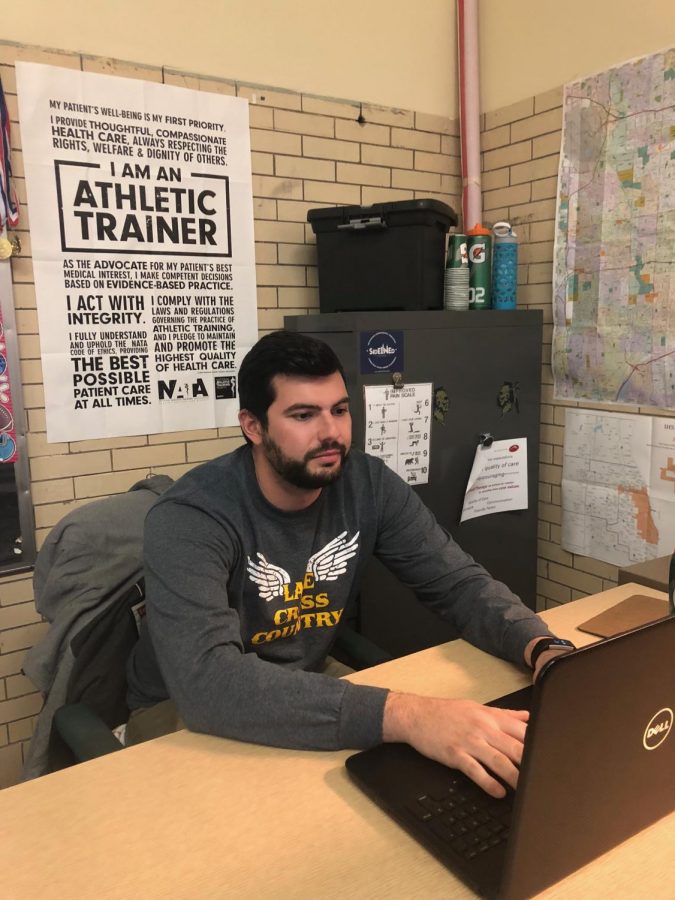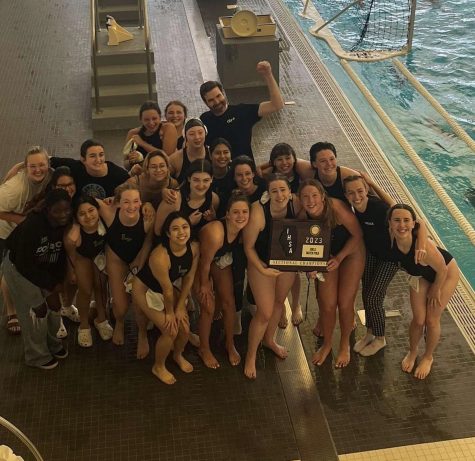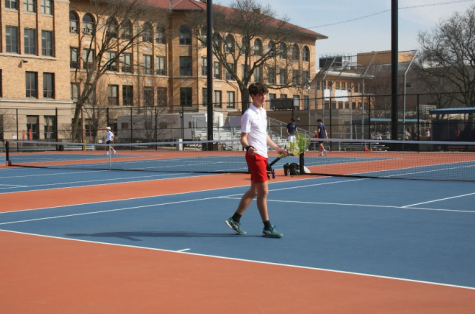Behind the gym walls: Lane athletic trainers
Athletic Trainer Aristides Adrahtas, better known as Ari, working on his laptop to log in information about current injuries.
A shot goes up but the ball bounces off the rim. A jumble of athletes wrestle for possession and after a few rebounds, the ball finally goes in.
Yet one athlete doesn’t run back on defense.
She remains on the ground clutching her face crying out in pain. Only a few notice this until the athletic trainer motions to the coach that the game needs to be paused. She slowly walks off the court and is now in the hands of an athletic trainer.
According to Fox News Health, 70 percent of public high schools surveyed had some sort of athletic training services. Lane has had a new athletic trainer every year for the past four years.
Chicago Public Schools has contracts with ATI Physical Therapy so physical trainers are hired every year, according to assistant athletic director Mrs. Milsap.
“CPS used to be in contract with Athletico, but now they use ATI because it’s cheaper,” Milsap said. “The past four years we had contracts with ATI.”
Gabby Lacour, Div. 959, along with Katie Andrews, Div. 985, assist the current athletic trainer, Aristides Adrahtas, also known as Ari.
Lacour and Andrews tape wrists, wrap ankles and organize what athletes need such as water and training equipment.
“Gabby knows this place better than I do at this point,” Adrahtas said. “She’s been helping out ever since she was a freshman or sophomore. Katie knows the inner workings of athletes as well, so they’re both great to have, and they’re wonderful assets.”
A majority of the time the choice to stay or leave the school is up to the trainer. Previous athletic trainer Mitch Wright is currently enrolled in medical school, according to Lacour who worked with Wright last year.
“A lot of times things change, family happens, or you want to further your career and step into a different field,” Adrahtas said. “It is yearly contracts, but most of the time it’s the athletic trainer that decides that they want to move on to something bigger or they want to move on to something for growth.”
Unfortunately, not all schools have athletic trainers. This is possibly due to lack of funding through CPS.
According to Adrahtas, having a trainer can give assessments on how bad the injury is and can save parents the hassle of setting up doctors’ appointments.
“I think are doing a disservice to their athletes because their athletes deserve someone that they can go talk to as opposed to something minor or major happens they automatically go see the doctor,” Adrahtas said. “I think it’s huge for any school that has athletics to have at least one athletic trainer and even if it was just for advising.”
Matthew Scott, Div, 051, plays football and runs track and has frequently been to the trainer’s room during his seasons.
“When you feel that something is uncomfortable or not right, the first step is seeing the trainer,” Scott said. “It’s really good because a lot of schools don’t have trainers, so we’re fortunate to have them every year.”
On an average day, about 30-50 people get treatment from the trainer, according to Adrahtas. Not only athletes but students who have injuries that want to be checked come as well.
“During the season we can have 10-15 kids here immediately after school, and maybe another 10 to come in for injuries that they suffered during the week,” Adrahtas said. “There are people coming in to get advice, minor things to get checked out, and sometimes people coming in with major stuff.”
Furthermore, the athletic trainer can also refer students to Dr. Garg, an ATI specialist who is the sports medicine doctor for the USA Men’s Hockey Team and for USA Women’s Soccer Team.
“Dr. Garg is nice because he comes to our football games, he’s our team doctor, and I trust him with the world,” Adrahtas said. “Anyone that is one of our athletes, Dr. Garg is already going to know what Lane is like, what our sports programs are like, he knows a lot of the coaches so it’s automatically a step ahead than any doctor in the area.”
Additionally, athletic trainers not only help athletes but staff and teachers as well. According to Adrahtas, he plans to stay at Lane for as long as he possibly can.
“I’m always willing to help and I’m never going to turn anyone down regardless of their status or who they are in the school or what they do even if they don’t do athletics,” Adrahtas said. “Teachers, staff, I’m always willing to help anyone. My office is always open.”
Thank you!! We met our goal for the 2023-24 school year! Your contributions covered our annual website hosting costs, which are no longer covered by our district/school. Student journalists at Lane Tech use this archive to research past coverage of various topics and link to past stories to offer readers additional context for current stories. Thank you for supporting the award-winning reporting and writing of journalism students at Lane Tech College Prep!
Background information on why the school district no longer allows our school to cover web hosting costs:
https://lanetechchampion.org/12583/uncategorized/special-coverage-impact-of-soppa-on-cps-students-teachers/
https://lanetechchampion.org/11702/opinion/staff-editorial-cpss-soppa-policy-is-choking-students-learning-and-the-champion/

Patricia Abulencia is a second-year journalist sports editor at Lane. She has a passion for writing stories which inspired her to join journalism in her...





